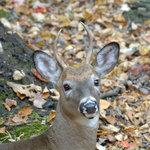This winter has been on the mild side. The rivers and lakes in the area have seen less ice than normal. So far, there has not been one night where the temperature has dropped below zero degrees. Most …
Stay informed about your community and support local independent journalism.
Subscribe to The River Reporter today. click here
This item is available in full to subscribers.
Please log in to continue |
.jpg)

This winter has been on the mild side. The rivers and lakes in the area have seen less ice than normal. So far, there has not been one night where the temperature has dropped below zero degrees. Most animals ignore the seasonal variations though; they prepare for winter as always. Migratory birds usually start their southbound trip about the same time every year, squirrels store a cache of acorns for the cold months, and other animals hibernate for the winter.
For some mammals, this means growing a winter coat to protect them from the cold. People who have dogs and cats are aware of the shedding process that periodically happens as evidenced by pet hair on beds and furniture. This process is called molting, where old hair is shed and replaced by new hair. With some animals, this is periodic (a rabbit sheds every three months or so) and with some animals, it is due to the change of seasons. Anyone who has worked with horses in the spring has likely seen lots of horse hair as their equine partners lose their winter coats.
The best example in this region of seasonal molting is the whitetail deer. This species molts twice a year. Deer molt in the spring with the arrival of warmer weather. They shed their winter coat and grow a thinner coat that has a rusty red or orange hue. Fawns that are born in mid-spring have the same hue, but with white spots. With the arrival of early fall, these cervids (mammal of the deer family) are molting again, replacing their summer coat with a thicker, grayish brown winter coat. The young-of-year fawns lose their spots at this time along with their summer coat.
During both molting seasons, deer may take on a “ratty” appearance, as patches of rusty red and darker brown are displayed at the same time on any given animal. Some people may mistake this for mange, which affects some mammals in the wild. With a normal molt, there will be fur from one season or another covering the skin, unlike a case of mange where areas of bare skin will be visible. These molting deer will soon rid of their disheveled appearance in a few weeks and have a brand-new summer or winter coat.
Comments
No comments on this item Please log in to comment by clicking here